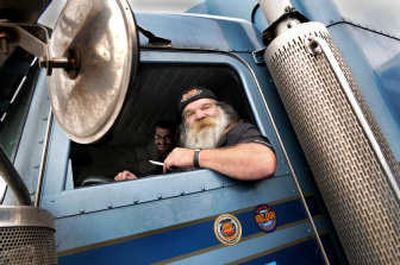The big road’s a no-go

You might call this the winter of Greg Klang’s discontent.
The long-haul truck driver from Atlanta has been idling for the past three days at the Petro Shopping Center on Interstate 90’s Medical Lake Road exit, where 50 to 60 rigs remained parked Friday afternoon.
He and his partner, Nick Hollis, both of Atlanta, have been sitting around, waiting for crews to knock down the avalanches on Snoqualmie Pass, including using dynamite to dislodge unstable snow.
Judging from their demeanor, the truckers weren’t too happy about traffic conditions in Washington.
“We could be taking Highway 395 down to I-84, over to Portland and up to Seattle,” Klang said as he sat behind the wheel. “But they won’t let us.”
“They” are the bosses back at CRST Premier Transport, who told Klang and Hollis not to go 300 miles out of their way in their tractor-trailer rig, which burns a gallon of gas every five miles.
“So instead, we’re burning a gallon an hour, sitting here losing our butts,” said Klang, who is paid by the mile.
Forecasters expected about 9 more inches to fall Friday night on Snoqualmie, part of a 72-mile section of I-90 from Edgewick to Ellensburg that has been closed since Tuesday. The pass reopened briefly Wednesday after an avalanche first shut it down.
Friday night, a state Transportation Department spokeswoman said officials hoped to reopen the pass early today “if all goes well.” Spokeswoman Claudia Cornish said that would depend on progress overnight after “a very successful day of clearing avalanche chutes.” The hope was to reopen Snoqualmie to traffic between 3 and 5 a.m.
“I am seeing historical levels of avalanche risk along the I-90 Snoqualmie Pass corridor,” said Craig Wilbour, of the Transportation Department, which kept avalanche crews working around the clock.
Motorists headed across the Cascades were advised to take the southern route through Portland.
At the Flying J in Ellensburg, manager Frieda Holloway reported that truckers were starting to move out in search of alternate routes, including the open but treacherous White and Stevens passes.
The Flying J parking lot had been full of semis for three days.
“We can park 75, and we had about 150 hanging around, backed up all the way down Canyon Road, bumper to bumper,” Holloway said.
At TW Transport, director of personnel Jeff Benesch was “monitoring the situation hourly, if not by the minute.”
Benesch said the Spokane-based trucking company was looking at alternate routes, Highways 2 and 12, as well as through Portland. Winter road closures are just part of the price of doing business in the Northwest, he said.
At the Flying J on Broadway in Spokane Valley, truckers Steve Smith and Mike Ranieri had been idling away the hours since 8 p.m. Thursday. Truck drivers idle primarily for cab comfort – heating and cooling – and to power appliances. In cold weather, drivers may keep engines running to prevent the engine block from freezing.
“We’ve got a bed, TV, PlayStation 2, laptop, and we’re parked next to a restaurant,” Smith said. “We’re OK.”